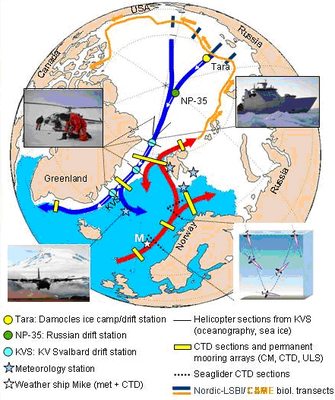
KV Svalbard drift station
iAOOS-Norway has used the Norwegian coastguard ice breaker KV Svalbard as a platform for two drift stations, in 2007 (three weeks) and in 2008 (six weeks). The vessel penetrated into the Transpolar Drift to about 80°-81° N. The ship then partly drifted and partly steamed south along the lower limb of the Transpolar Drift, across the DAMOCLES freshwater and ice thickness observational array at 79° N, and southwards. Helicopter sections (ice thickness profiling, short ice stations with oceanographic measurements and snow and ice surveys) were made across the drift stream. The sampling was a combination of stations moored to selected ice floes, and stations during the southward steaming. KV Svalbard has earlier supported NPI in Fram Strait during winter conditions, and has demonstrated its ability to perform well in heavy multiyear ice.
Helicopter sections from KV Svalbard
Helicopter sections (ice thickness profiling), short ice stations with oceanographic measurements and snow and ice surveys) were made across the drift stream.
Weather ship Mike (met + CTD)
The ship holds a fixed position at 66°N, 2°E, and makes daily meteorological observations and weekly oceanographic observations. The measurements have been made since October 1, 1948, and the time series represent a unique data set for studies of climate change in the atmosphere and ocean, and exchanges between the two.
CTD sections and permanent mooring arrays
iAOOS-Norway with its partner institutions maintain mooring arrays at Svinøy, and the Barents Sea Entrance and at the Fram Strait.
Seaglider CTD sections
Glider operations are perfomed at Station Mike, at Svinøy, and at the Southwest tip of Spitsbergen.
NP-35: Russion drift station
Following the Fram drift of Fridtjof Nansen (Nansen, 1906), Arctic ice drifting stations have been performed since the 1930s. Task 1.4 of DAMOCLES (leader S. Gerland) includes the installation of spectral radiometers for high resolution monitoring of evolution of spectral surface albedo and spectral transmittance of the snow and ice layer, and regular observation of relevant snow parameters. Corresponding monitoring is planned for the Russian Arctic Ice Drifting Station NP-35 during IPY, as a continuation of a Norwegian-Russian collaborative project on NP-33/2005.
Under IAOOS-Norway, additional spectral albedo surveys are planned at Tara and NP-35 during stays when installing the monitoring equipment. Those non-automatic measurements will give a broader wavelength range, and many different surfaces can be investigated by moving the spectroradiometer (ASD Fieldspec Pro, 350-2500 nm wavelength range). Furthermore, about 2 km each of ice thickness profiles using a portable electromagnetic induction device (Geonics EM31) are planned at both sites for mapping the snow and ice thickness distribution. Stays of about 1-2 weeks duration per station are planned.
Soviet and now Russian drifting ice stations are named "Severnyy polyus" (Russian: «Северный полюс»; English: "North Pole") and are abbreviated SP (Russian: «СП»; English: "NP"). Each station is assigned an ordinal number. The first scientific drifting ice station in the world, North Pole-1 was established on May 21, 1937 some 20 km from the North Pole by the expedition into the high latitudes Sever-1, led by Otto Schmidt. "NP-1" operated for 9 months, during which the ice floe passed 2,850 kilometers. The crew regularly measured ocean depth, took bottom soil samples, measured water temperature, took water samples from different levels, and carried out meteorological observations. In February 1938 the "North Pole" station drifted out to the Greenland Sea, and after several attempts, the camp was evacuated successfully with the help of an icebreaker.
Tara: Damocles ice camp/drift station
In the framework of DAMOCLES, energy balance measurements will be performed on the ice drifting station Tara. The Tara drift station is constructed around a sailing ship which is drifting with the ice in Fram style, with scientific instrumentation maintained by the crew. It started its drift with the Arctic transpolar drift across the Arctic Basin in September 2006. Tara will be anchored in the arctic pack-ice by 82° north and will be delivered from it nearly two years later after a 1800 kilometer drift.
During its two-year drift among Arctic pack-ice, Tara will be the spaceship of the Damocles observing system, in charge to collect data related to sea-ice, atmosphere and ocean. Its location, in the heart of Arctic Ocean will allow to service a sophisticated autonomous buoys web, disseminated in a 500km range around the ship.
Through an ambitious educational program, it also will be the opportunity to coordinated dissemination (public outreach) of scientific data collected during the whole International Polar Year (2007-2008). Read more on Tara on www.damocles-eu.org and on Tara expedition website.

